|
|

Following are guidelines to assist you in properly connecting the external network cables.
The following sections discuss how to connect cables to all of the available interfaces on the Cisco 7000 interface processors and the main system processors.
An Ethernet transceiver or MAU should already be connected to your network. Connect each Ethernet port on the EIP to an Ethernet transceiver with a transceiver cable, or to an attachment unit with an AUI, as shown in Figure 4-1.

On each EIP port, slide the metal bracket up over two posts on the cable connector, or tighten the thumbscrews to secure the cable in the port and provide strain relief. Some miniature transceivers (usually the 10BaseT type) connect directly to the Ethernet port on the EIP and do not require an interface cable.
For an MII connection, a 100BaseT transceiver or MAU should already be connected to your network. An RJ-45 connection does not require an external transceiver. On a single 100BaseT port adapter, you can use either the RJ-45 connection or the MII connection. If you have two port adapters on your FEIP, you can use the RJ-45 connection on one and the MII connection on the other, as shown in Figure 4-2.

If you have RJ-45 connections, attach the Category 5 UTP cable directly to the RJ-45 port on the FEIP. If you have MII connections, attach an MII cable directly to the MII port on the FEIP, or attach a 100BaseT or 100BaseF transceiver, with the media appropriate to your application, to the MII port on the FEIP. RJ-45 and MII cables are not available from Cisco Systems, but are available from other cable vendors.
Attach the network end of your RJ-45 or MII cable to your 100BaseT or 100BaseF transceiver, switch, hub, repeater, DTE, or similar external 100BaseT equipment.
Token Ring MAU connectors provide a direct connection between the TRIP and the ring, as shown in Figure 4-3.

Specific CIP connection requirements for bus and tag or Enterprise System Connection (ESCON) cables are discussed in detail in the configuration note Channel Interface Processor (CIP) Installation and Configuration, which is available on UniverCD or as a printed copy (Document Number 78-1342-xx, where xx is the latest version of the document). This configuration note also ships with CIP-related spare parts.
Both single-mode and multimode, single and dual attachment connections are available and can be combined on one FIP. Fiber-optic cable connects directly to FIP ports. Single-mode uses separate transmit and receive cables. All single-mode products meet the Class 1 Laser Emission Requirement from the Center for Devices and Radiological Health (CDRH) FDDI. Multimode uses one transmit/receive cable for each physical sublayer (PHY) interface.
Connect single-mode, single attachment as shown in Figure 4-4.
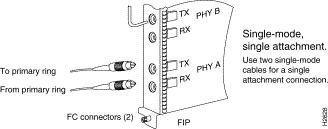
 | Warning Invisible laser radiation may be emitted from the aperture ports of the single-mode FDDI products when no fiber cable is connected. Avoid exposure and do not stare into open apertures. (For translated versions of this warning, refer to the appendix "Translated Safety Warnings.") |
The aperture port contains an FDDI warning label, as shown in Figure 4-5.

Connect multimode, single attachment as shown in Figure 4-6.
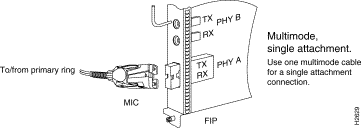
Connect single-mode, dual attachment as shown in Figure 4-7.

Connect multimode, dual attachment as shown in Figure 4-8.

For mixed-mode configurations, the primary ring signal is received on the multimode PHY A receive port and transmitted from the single-mode PHY B transmit port.
For mixed-mode configurations, connect the cables to the FIP ports as follows:
Your configuration may be opposite, with multimode connections on PHY B and single-mode connections on PHY A.
Connect mixed-mode configurations as shown in Figure 4-9.
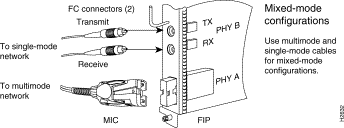
Connect the optical bypass switch as follows:


Step 2 Connect the cable coming in from the secondary ring (from PHY A at the preceding station) to the PHY B receive port on the network (ring) side of the bypass switch.
Step 3 Unless the documentation that accompanies the bypass switch instructs otherwise, consider the bypass switch an extension of the FIP ports and connect the switch cables from A to A and B to B. The network cables are already connected to the bypass switch following the standard B-to-A/A-to-B scheme.
All FSIP ports support any available interface type and mode. The serial adapter cable determines the electrical interface type and mode of the port to which it is connected. E1-G.703/G.704, EIA/TIA-232, EIA/TIA-449, V.35, and X.21 interfaces are available in DTE mode with a plug at the network end and in DCE mode with a receptacle at the network end. EIA-530 is available only in DTE mode with a plug. Connect the FSIP serial cables as shown in Figure 4-12.

When you connect serial devices, consider the adapter cables as an extension of the router for external connections. Therefore, use DTE cables to connect the router to remote DCE devices such as modems or DSUs, and use DCE cables to connect the router to remote DTE devices such as a host, PC, or another router.
A pair of metric thumbscrews is included with each port adapter cable. If you plan to connect to a remote device that uses metric hardware, replace the standard 4-40 thumbscrews at the network end of the port adapter cable with the M3 metric thumbscrews. Also, the backshell on the FSIP universal cable connector is not stiff enough to prevent you from inserting the interface cable connector into the FSIP port upside down.
 | Caution Forcing a SIP cable into an FSIP port or forcing an FSIP cable into the port upside down can damage the FSIP. Before inserting the cable into the FSIP port receptacle, ensure that the connector is oriented correctly. (See Figure 4-13.) |
Figure 4-13 shows the correct and incorrect ways to attach serial interface cables to the FSIP.
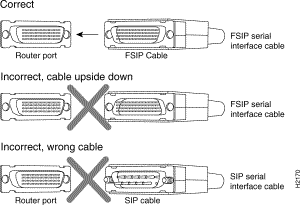
The HIP port functions as a DTE when it is connected to a DSU for a standard HSSI connection; it can also be connected to a collocated router with a null-modem cable. To connect the router to an HSSI network, use an HSSI interface cable between the HIP port and the DSU. HSSI cable ends are identical; connect them as shown in Figure 4-14.

To verify the operation of the HSSI port or to build a larger node, use a null modem cable between two HSSI ports and connect two routers back to back, as shown in Figure 4-15.

The two routers must be in the same location, and can be two Cisco 7513s or one Cisco 7513 and one Cisco 7000. When you configure the ports, you must enable the internal transmit clock on each HSSI interface with the hssi internal-clock command. When you disconnect the cable, use the no hssi internal-clock command. For complete descriptions of these commands, refer to the appropriate configuration publications, which are listed in the section "If You Need More Configuration Information," in the chapter "Performing a Basic Configuration of the Cisco 7000."
The AIP can support interfaces that connect to the following physical layers:
Connect AIP cables as shown in Figure 4-16.

The aperture port contains a warning label, as shown in Figure 4-17.

 | Caution To ensure compliance with EMI standards, the E3 PLIM connection requires an EMI filter clip (CLIP-E3-EMI) on the receive port (RCVR); the DS3 PLIM connection does not require this clip. The following procedure and figure discuss the EMI filter clip assembly that is required for the E3 PLIM. Do not operate the E3 PLIM without this assembly. |
Following is the procedure for installing the CAB-ATM-DS3/E3 cable and the EMI filter clip:
One portion of the cable has a white insulator on both ends to ensure that the receive-to-transmit and transmit-to-receive relationship is maintained between the E3 PLIM and your ATM switch. The white banded portion of the cable should attach between receive and transmit or transmit and receive ports of the E3 PLIM and your ATM switch, respectively.
Step 2 Hold the EMI filter clip as shown in B in Figure 4-18.
Step 3 Attach the EMI filter clip to the receive cable, as shown in C in Figure 4-18.
Step 4 To ensure that the clip is not pulled off when adjacent interface processors are removed, position the clip parallel to the orientation of the AIP, as shown in C and D in Figure 4-18.
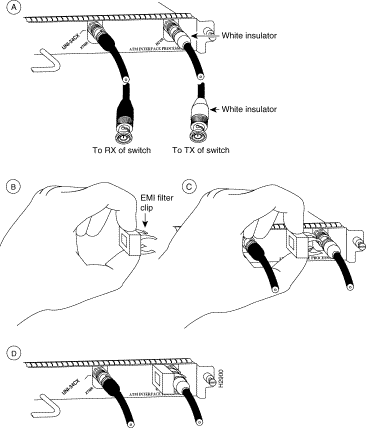
Four E1 cables are available from Cisco Systems and other vendors for use with the MIP: BNC, Twinax, DB-15, and RJ-45. The E1 cables used to connect the MIP with external E1 equipment have a DB-15 male connector on the MIP end.
Connect the MIP cables as shown in Figure 4-19.

The console port on the RP (or RSP7000) is a DCE, DB-25 receptacle for connecting a data terminal, which you need to configure to communicate with your system. The auxiliary port is a DTE, DB-25 receptacle for connecting a modem or other DCE device (such as a CSU/DSU or other router) to the system.
Before connecting the console port, check your terminal's documentation to determine its baud rate, which must match the default baud rate (9600 baud) of the console port on the RP (or RSP7000). Set up the terminal as follows: 9600 baud, 8 data bits, no parity, 2 stop bits. On the RP (or RSP7000), the console port is located below the auxiliary port.
Connect the console and auxiliary ports as shown in Figure 4-20.
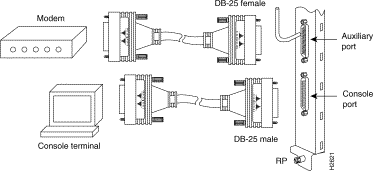
Following is the procedure for connecting a 700W DC-input power supply. You will need a medium flat-blade screwdriver, two nylon cable ties, and wire cutters for this procedure.
Step 2 Using a screwdriver, loosen the captive installation screws on the terminal block cover, then lift and remove the cover. (See Figure 4-21.)
 | Warning When stranded wiring is required, use approved wiring terminations, such as closed-loop or spade-type with upturned lugs. These terminations should be the appropriate size for the wires and should clamp both the insulation and conductor.(For translated versions of this warning, refer to the appendix "Translated Safety Warnings.") |
 | Warning The illustration shows the DC power supply terminal block. Wire the DC power supply using the appropriate lugs at the wiring end, as illustrated. The proper wiring sequence is ground to ground, positive to positive (line to L), and negative to negative (neutral to N). Note that the ground wire should always be connected first and disconnected last. (For translated versions of this warning, refer to the appendix "Translated Safety Warnings.") |

 | Warning Incorrectly wiring the terminal block could create a dangerous shock hazard and could damage the power supply, power source, and the chassis components. |
Step 3 To provide strain relief for the three DC-input cable, attach two nylon ties around the cable and the metal bracket. (See Figure 4-21.)
Step 4 Install the terminal block cover over the terminal block and tighten the captive installation screws. (See Figure 4-21.) Do not overtighten the captive installation screws on the terminal block cover. The recommended torque is 8.2 ±0.4 inch-lb.
 | Warning To prevent a short-circuit or shock hazard after wiring the DC-input power supply, replace the terminal block cover. |
Step 5 Connect the opposite end of the DC-input cable to the DC power source.
Step 6 If you are installing or replacing a second power supply, repeat Step 1through Step 5 for the second power supply.
After you have finished installing your Cisco 7000 hardware, and connecting all the cables, and before you turn on the power, verify the following:
After your hardware installation is complete, and all required cables are connected, proceed to the chapter "Performing a Basic Configuration of the Cisco 7000."
![]()
![]()
![]()
![]()
![]()
![]()
![]()
![]()
Posted: Fri Oct 19 16:31:22 PDT 2001
All contents are Copyright © 1992--2001 Cisco Systems, Inc. All rights reserved.
Important Notices and Privacy Statement.